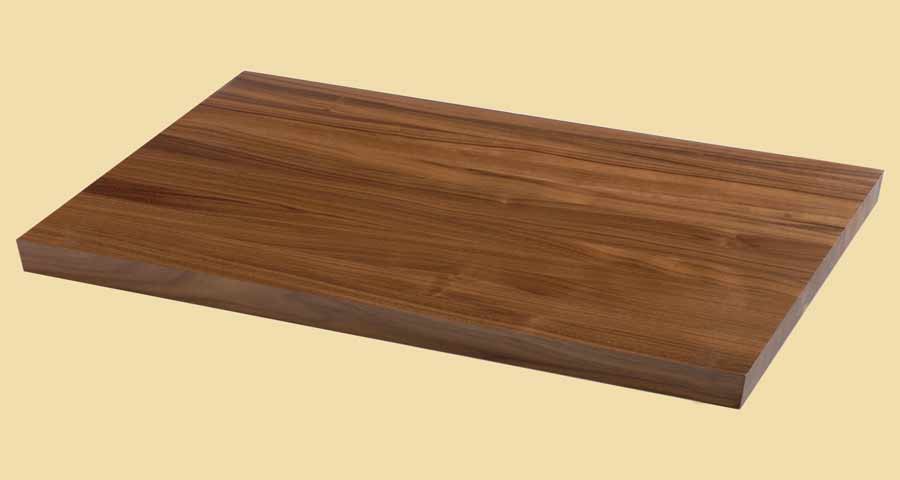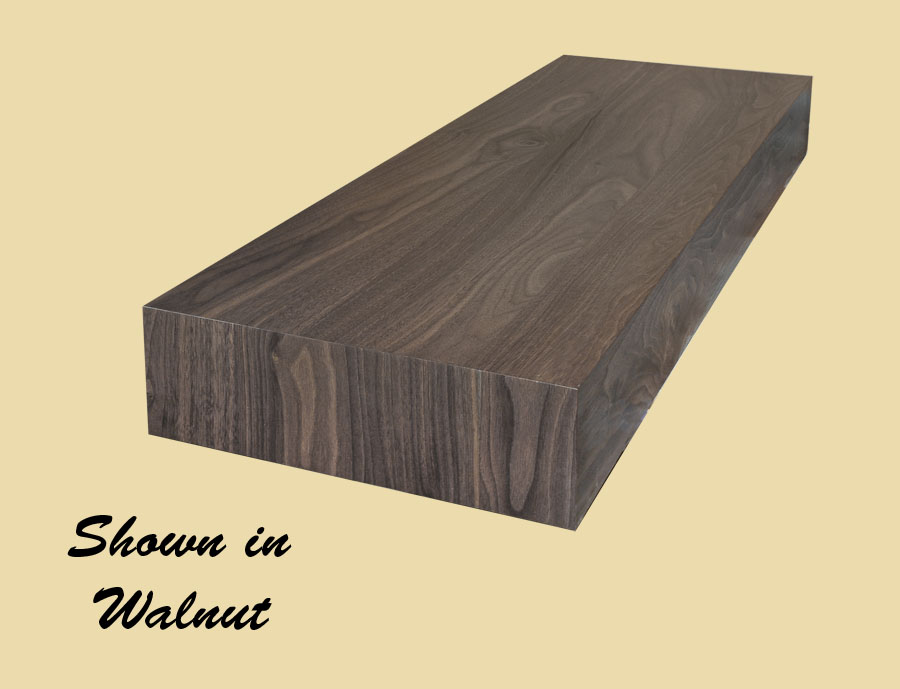Hardness Ratings Of Our Wood Choices
The following ratings are taken from The Janka Hardness Scale. It is a measurement of the amount of force needed to embed a .444" steel ball into wood to half the ball's diameter. It is a great tool for comparing densities of different species of wood.
We have a wide variety of products using the types of wood listed below. Wood countertop styles include butcher block countertops, end grain butcher block countertops and plank countertops. Stair treads are offered as full thickness (standard) stair treads, replacement (retro-fit) stair treads and extra thick stair treads. Many of the wood choices are available as hardwood flooring, kitchen cabinet doors and many other products. Please use the menu of the left to see a complete product listing and the wood choices available for each product.
Click on the wood name for a description.
| Alphabetical Order | Highest to Lowest | ||
| American Cherry: | 950 | Brazilian Cherry: | 2350 |
| Ash: | 1320 | Hickory: | 1820 |
| Beech: | 1300 | Hard Maple: | 1450 |
| Brazilian Cherry: | 2350 | White Oak: | 1360 |
| Hard Maple: | 1450 | Quartersawn White Oak: | 1335 |
| Hickory: | 1820 | Ash: | 1320 |
| Knotty Alder: | 590 | Beech: | 1300 |
| Knotty Pine: | 420 | Red Oak: | 1290 |
| Mahogany: | 830 | Quartersawn Red Oak: | 1290 |
| Poplar: | 540 | Walnut: | 1010 |
| Quartersawn Red Oak: | 1290 | American Cherry: | 950 |
| Quartersawn White Oak: | 1335 | Soft Maple: | 950 |
| Red Oak: | 1290 | Mahogany: | 830 |
| Soft Maple: | 950 | Spanish Cedar: | 600 |
| Spanish Cedar: | 600 | Knotty Alder: | 590 |
| Walnut: | 1010 | Poplar: | 540 |
| White Oak: | 1360 | Knotty Pine: | 420 |
American Cherry: 950
This is a light to medium density wood. American cherry finishes to a glass-like smoothness which makes it highly desirable. The colors range from a red or reddish-brown in the heartwood while the sapwood is a light pink to yellowish. The moderately hard American cherry has a fine, closed grain.
Ash: 1320
The heartwood has a light brown color while the sapwood can be a beige or brown, making it quite indistinguishable from the heartwood. But there are darker shades, sold as olive ash separately. The grain may also have an occasional brown streak running through. Grain is also straight and regular with very few discrepancies, although it isn't difficult to spot somewhat curly and figured boards. Ash has medium coarse texture that feels very much like that of oak. It is a medium density wood that is strong and also has shock resistant properties.
Beech: 1300
The medium wood has good strength. Beech sapwood varies in color from a pale cream color to brilliant white. Heartwood can be brown or a deep purple-brown. It has a medium open grain that runs straight. The texture is quite fine with medium uniformity and an average natural luster. The flatsawn beech tends to look very bland and uniform. But the excellent shock resistance and heavy density more than make up for it.
Brazilian Cherry: 2350
This is an exceptionally strong and hard type of wood. The colors in the heartwood vary from a light orange-brown to a dark reddish brown, there may also be some grayish brown streaks through the wood. Sapwood is a light grayish yellow. Exposure to sunlight tends to darken the colors even more. The grain is usually interlocked with the texture ranging from medium to coarse.
Hard Maple: 1450
A dense wood that is light in color, hard maple has a fine texture with close grains and a uniform texture. The colors can be anywhere between a creamy white to an off white, occasionally imbued with a brownish-red heartwood. Hard maple has a medium to heavy density that makes it heavy and strong as well as shock and abrasion resistant.
Hickory: 1820
Hickory is strong, hard and very durable, making it perfect for a wide range of applications. The colors vary from an off white to almost yellow sapwood and tan red-brown heartwood. The heart and sap mixture can vary greatly. The reasonably coarse, normally straight open grain may also be wavy at times. Hickory's density is classified at very stiff, hard and heavy.
Knotty Alder: 590
This is a light and soft density hardwood that is a lot softer than oak and walnut. The grain has a straight, even appearance with an even texture. It looks quite similar to cherry with a reddish-brown color and it reacts very well to stain finishes. Knotty alder has many knots; these include pin knots and closed and open knots in different sizes. This imparts an endearing, rustic appearance that adds to the personality of any space.
Knotty Pine: 420
It is a soft, lightweight wood with a straight grain and fine texture. Knotty pine is known for a subdued grain pattern that can vary in color from a creamy light yellow to a more mid-tone yellow. Knotty pine's rustic charm can be contributed to the knots that tend to be small and tight and are prevalent throughout the wood. The random appearance of these knots gives it a historic look. Knotty pine can also display "Blue Stains" that are caused by a natural reaction inside the wood.
Mahogany: 830
The straight, grain with parallel interlocking runs is characterized by a coarse texture. The mahogany colors can vary from blood red to a light/dark reddish brown. Although rare, mahogany sometimes also appears in lighter colors with ranging from gray to a pale red. The density is relatively light.
Poplar: 540
This wood has a straight, uniform grain that comes in a medium texture. Poplar is a light, almost white colored timber with a soft, low density. The colors can range from a very pale yellow to white, the heartwood and sapwood are hardly distinguishable. The texture is very fine with a low natural luster that gives it an unequaled appearance.
Quartersawn Red Oak: 1290
When red oak is quartersawn, its characteristic flake patterns become visible. These are spectacular large rays that look quite attractive. The colors run from a pinkish red to a light tan or blonde. The course textured wood is medium density.
Quartersawn White Oak: 1335
The quartersawn white oak displays the flake pattern or tiger rays of the white oak very beautifully without compromising on the high density. The color ranges from a creamy light brown to a more pronounced brown. But there might also be an occasional reddish brown tinge to quartersawn white oak.
Red Oak: 1290
This medium density wood is quite easy to work with. It is available in colors ranging from a pinkish red to blonde. The grain is openly porous and shows dramatic patterns. The broad grains give it a very distinctive appearance. Red oak carves and bends well and lends itself beautifully to all sorts of modern woodworking.
Soft Maple: 950
It has a close-grained texture. There is also some minor mineral streaking. This wood is considered quite stable with a light to medium hardness and density. The close grains and fine texture means that there is no need for filling. The colors for the sapwood can range from cream to grayish white while the heartwood shows brown to greenish brown tinge with minor mineral streaks. There may also be some flecking evident.
Spanish Cedar: 600
When freshly cut, the Spanish cedar heartwood has a pinkish or reddish-brown brown color. But after it has been exposed to the sun for a while, the colors tend to darken and turn red or dark red. It is a straight grain wood that is light yet strong and durable. The grain patterns are almost invisible and bland with the grain being straight and interlocked at shallow intervals.
Walnut: 1010
This is a very durable and strong wood but at the same time it is very rare. The coloration varies from a light to dark, chocolate brown in the heartwood, while the sapwood is plain white or pale yellow-gray. There are also plenty of visible butts, curls and burls in the grain. The wood is usually steamed to darken the sapwood to a light brown or coffee color, to achieve color uniformity. The grain is moderately open and straight, but it may also be irregular at times. The grain also has a moderate texture and natural luster. Walnut wood has a fairly light weight density.
White Oak: 1360
The heartwood colors tend to vary from a light tan to brown while the sapwood colors range from a creamy white to gray. But there is a good amount of variation in color. The grain is moderately open when white oak is plain sawn. This type of wood is very resistant to environmental distresses. It is a medium to high density wood with a coarse grain and medium to large pores.


